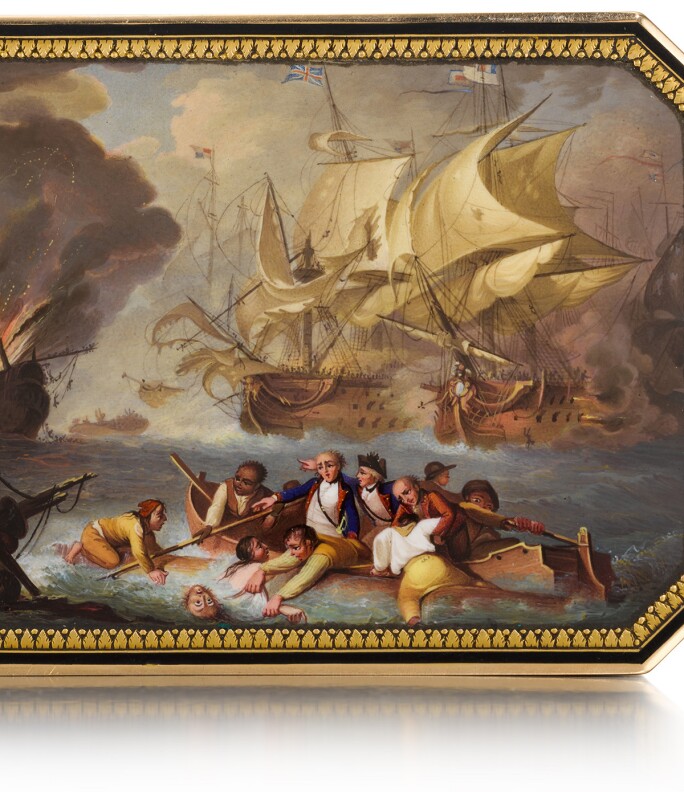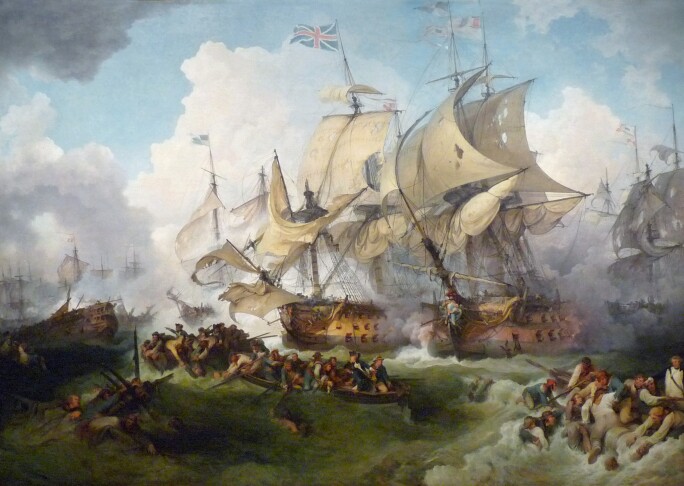The battle known in England as the ‘Glorious First of June’ and in France titled the ‘Combat de Prairial’ took place on 1 June 1794 and was the culmination of the naval fight between the rivalling fleets of Great Britain and the First French Republic. The French Atlantic Fleet under Rear Admiral Louis-Thomas Villaret-Joyeuse (1747-1812) and the British forces commanded by Admiral Lord Howe (1726-1799) clashed in the Atlantic ocean. Lord Howe’s unconventional order to his fleet to turn towards the French battle ships and attack their immediate opponent led to some misunderstandings among his captains, yet ultimately led to a tactical victory.

News of the victorious actions of the British Channel Fleet under Admiral Lord Howe’s command over an important French convoy of vessels in the ‘The Glorious First of June’, also known as the Fourth Battle of Ushant, were quick to be received with rejoicings in Britain and elsewhere on the continent. The London Gazette of 3 June 1794 printed an account of the action, followed by further details in all the principal newspapers in the ensuing days.
Although a decade lies between the actual historical event of the Glorious First of June and the depiction thereof in intricate enamel in the present lot, the box still belongs to a small group of gold and enamel ‘history painting’ snuff boxes made by the eminent Genevois bijoutiers around the turn of the 18th century. Another gold and enamel box painted with a nearly contemporary military battle, representing the second siege of Oczakow in 1788, marked for the earlier business partnership of Rémond under the name of Guidon, Rémond, Gide & Co, Geneva, 1792, was sold at Sotheby’s London, Gold Boxes, Ceramics and Silver, London, 26 May 2021, lot 50; two more boxes with episodes representing the siege have been recorded so far (one is now in the collections of the Hermitage Museum, inventory number Э-10942; the other sold Bonham’s London, 12 November 2014, lot 2). Yet another gold and enamel history painting box, representing the battle of Hogland occuring in 1788 as part of the Russo-Swedish War, by the Hanau firm of Les Frères Toussaint, was sold at Sotheby's London, 26 May 2021, lot 12.

The present lot with the brightly-lit scene of shipwrecked soldiers being rescued from the ocean, another sinking battleship hit by an intense explosion to the left below columns of smoke and a dark and moody lighting, vividly demonstrate the stylistic particularities of Geneva enamel boxes during the period between 1801 and 1804. During those years, ‘the greatest innovations are made (…), variously shaped plaques or en plein panels are framed by pearls or boldly chased gold work, and on sides we firstly see the fabric-like patterns under translucent enamel that no rivals were able to imitate. At this time the themes are dramatic, colourful and classical, copied from academic paintings of Roman or Greek history’ (Julia Clarke, ‘Swiss Snuff Boxes 1785-1835’, in: Enamels of the World 1700-2000, The Khalili Collections, Haydn Williams, 2009, p. 299). The present lot combines the aforementioned fabric-like patterns on the sides and base with the drama of a real naval battle painted as a pastiche from contemporary history paintings, such as Philippe-Jacques de Loutherbourg’s The Glorious First of June, 1795, (fig. 1, now in the National Maritime Museum in Greenwich) or engravings after this painting.